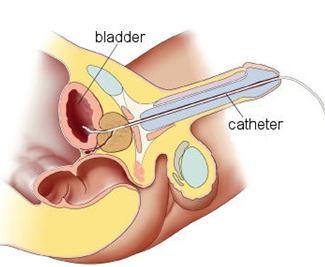Get 15% Off*, Use Code: HPMT15
Get 15% Off*, Use Code: HPMT15

 Reviewed by Christine Kijek, Registered Colorectal Nurse, on September 6, 2022
Reviewed by Christine Kijek, Registered Colorectal Nurse, on September 6, 2022
Intermittent Catheters | Indwelling Foley Catheters | External Condom Catheters
In America, there are millions of men who need to use catheters every day. The reasons for this are plenty, and so are the options available to male patients. The two main causes for the need for a urinary catheter are the inability to completely empty one's bladder (urinary retention) and the emptying of the bladder at inappropriate times (incontinence). The anatomical differences between men and women create some unique circumstances for males. Many men have felt the stigma of a bladder that doesn’t work properly, so they may withdraw socially and derail from experiencing a fulfilling lifestyle. What men need to understand is there is no shame, and there are numerous types of catheters for men that allow them to regain their freedom and lifestyle.
 I’m sure if you were to ask men if they prefer to use a catheter, they would say no, but there are many reasons why they need this for a healthy lifestyle. The reasons for catheter use can vary from man to man, but all have one thing in common: they prevent the proper emptying of the bladder. The National Institutes of Health have identified several factors that can lead to catheter use.
I’m sure if you were to ask men if they prefer to use a catheter, they would say no, but there are many reasons why they need this for a healthy lifestyle. The reasons for catheter use can vary from man to man, but all have one thing in common: they prevent the proper emptying of the bladder. The National Institutes of Health have identified several factors that can lead to catheter use.
The act of male urinary catheterization is relatively simple, the eyelid side of the catheter is inserted into the urethra (taking care not to touch it with anything that is not sterile) until the tip reaches the bladder and the urine starts draining. Whether the cause is bladder/prostate cancer, diabetes, or an injury, there are many options for patients to accommodate just about everyone’s lifestyle.
As you can imagine, men have different needs as well as different lifestyles. With this in mind, there are many different options to accommodate most men when it comes to their catheterization needs. The first step in determining what might work for you is to identify what specific medical needs you may have. Your urologist can help with this process by giving you the pros and cons of each catheterization system. WebMD.com notes that there are basically three different types of catheters for men. They are:
Even silicone-coated PVC in order to give patients a variety of options. Another factor that can influence your decision on catheter style is the extent of your injuries. For instance, somebody affected by a spinal cord injury that won’t allows the patient to self-catheterize might opt to use a Foley catheter since they cannot self-cath. For an enlarged prostate, using a Coude tip (curved tip catheter) may allow for easy insertion around an obstruction.
Even among these types of catheters for males, variations allow patients to choose what might fit them the best. Many of them can be carried discreetly in a man’s pocket and are known as male pocket catheters.
Some men may need to use an indwelling catheter like the Foley catheter. These stay in place and are held by an inflated balloon in the bladder to prevent slippage. Just like with intermittent catheters for men, there are many different variations of male Foley catheters in order to accommodate just about every patient's needs. A two-way Foley catheter has two separate “branches” to allow for balloon inflation and urine drainage.
Foley catheters for men are also available in three-way variations. These allow for a third option of irrigation, in addition to urine drainage and balloon inflation.
Male external catheters are unique to men since the condom fits over the male penis. They are easy to use but should only be for short-term use. While convenient, over time, skin irritation and urinary blockage can occur. Much like Foley catheters and intermittent catheters, they also offer many options to patients, such as silicone or latex.
No matter the reason or what the injury or illness might be, there are options for men so that incontinence does not dictate your lifestyle. It may take some trial and error or mixing and matching, but overcoming the stigma of using catheters is your first step toward regaining your independence.
At HPFY, you will get a premium range of urinary catheters for men's needs. Our collection includes a variety of catheter types, materials, and sizes, ensuring you find the perfect fit for your unique requirements. Your well-being is our priority – let us be your partner in this journey toward a more comfortable and fulfilling life.
For some men, catheter insertion may cause only minimal discomfort or pressure. For others, especially those who are experiencing urinary retention or have certain medical conditions, the procedure can be more uncomfortable and may cause temporary pain or a sensation of burning. To minimize discomfort during catheter insertion, healthcare providers often use catheter lubricants and ensure that the process is carried out with care and expertise.
Sleeping with a catheter requires a few adjustments for comfort. Opt for loose clothing to prevent pressure on the catheter, and choose a comfortable sleeping position, often on your back or side. Position the catheter tubing to avoid tangles or pulls by using tape or a catheter holder. Ensure the drainage bag is below your bladder and emptied before sleeping. Use soft bedding to minimize friction and discomfort. It might take time to adjust, so be patient and consult your healthcare provider for any concerns.
The duration varies depending on the type of catheter for men and the medical condition. Intermittent catheters are used temporarily, while indwelling catheters may stay in place for days to weeks.
Disclaimer: All content found on our website, including images, videos, infographics and text were created solely for informational purposes. Our content should never be used for the purpose of diagnosis or treatment of any medical conditions. Content shared on our websites is not meant to be used as a substitute for advice from a certified medical professional. Reliance on the information provided on our website as a basis for patient treatment is solely at your own risk. We urge all our customers to always consult a physician or a certified medical professional before trying or using a new medical product.

Kevin Cleary has been a Health Products For You contributor for many years and has a degree in marketing. His health and wellness journey has a very personal meaning and has guided him in his content writing for HPFY.
In 2006, ...
How To Increase Iron Levels Quickly
It’s a question that must have puzzled you like many others. Iron is essential in hemoglobin production and its inadequate levels can negatively impact your health. Dive into this informative article to explore top iron-rich foods that can help you fight iron deficiency.
10 Best Coccyx Cushions for Tailbone Pain
If you're like most people, you spend about 8 to 10 hours sitting every day. However unhealthy, it is part of life for many, and can cause tailbone pain. Coccyx cushions can help alleviate this pain. Click to read more and find the perfect coccyx cushion for your tailbone pain.
5+ Best Adult Diapers for Fecal Incontinence
Dealing with fecal incontinence can be challenging, but you're not alone. Read this article and navigate through discreet and effective solutions that help you manage fecal incontinence and let you live life on your terms with confidence and comfort.
Top 5 Best Reviewed Nebulizers of 2024
Need an effective and affordable nebulizer? Look no further, in this article we offer 5 of our best reviewed nebulizers that are loved by our customers. Click to read more and find the perfect nebulizer for all your respiratory needs.
10 Best Penis Pumps For Erectile Dysfunction
For anyone dealing with erectile dysfunction, penis pumps serve as a great way to manage it. But with so many products available, determining the best one for your needs can be challenging. To assist you in refining your choices and making an informed decision, here are our top 10 options, recognized for their effectiveness and safety.